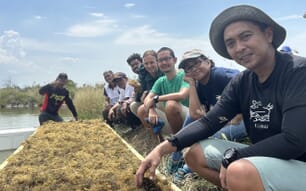This is one of the key findings of a new paper, Boom-and-bust Production Cycles in Animal Seafood Aquaculture, which notes that, although global aquaculture production has grown at a compound annual rate of 8.2 per cent since 1950, growth has slowed down to 6.2 per cent in the last 15 years.
“We were surprised ourselves at how widespread these boom-and-bust production cycles are in the FAO records. Boom-and-bust production cycles have historically occurred in small aquaculture stocks, but the real worry is that the pattern is spreading to larger and larger stocks to have an increasing impact on global aquaculture production and aquatic biodiversity. We need to know more about diseases and on how to breed robust, disease- and stress-resistant aquaculture stocks,” says Dennis Hedgecock, who co-authored the paper with Weiwei You.
The paper describes how early adopters of “new” in-demand species often enjoy high financial returns, fuelling the rapid and uncontrolled proliferation of imitators in numbers and densities, thereby often far exceeding ecological carrying capacities (Arquitt et al. 2005). A combination of diseases, market saturation and other factors eventually topple production viability, leading farmers to shift to other species.
Following Doyle (2016), the authors hypothesise that – in some species – inbreeding depression might be an ultimate cause of increasing disease susceptibility. Starting with Wilkins and Mathers in 1973, many researchers have compared genetic diversity in both wild and cultured shellfish populations and concluded that hatchery-propagated shellfish lose genetic variation and exhibit inbreeding depression, making them far more vulnerable to disease and viral outbreaks.
Historical examples of boom-and-bust cycles include the farming of variously-coloured abalone (Haliotis diversicolor) – production crashed by 95 per cent in both China and Taiwan following a 2003 virus outbreak. Similarly, separate viruses caused farmed stocks of black tiger prawn (Penaeus monodon) to plummet by 95 percent in Taiwan in 1998 and in Thailand in 2001.

© Gregg Yan / Best Alternatives
“Most aquaculture production occurs in Asia, by the hands of smallholder farmers, who appear to be particularly vulnerable to boom-and-bust production cycles. These farmers need to know about the dangers of intensifying production too rapidly and they need access to disease-resistant seed,” says Dr You.
By analysing FAO production data – particularly on molluscs, crustaceans, including marine shrimp, plus fish reared in marine and brackish water – the authors found a strong association between short boom phases (five years or less) and the probability of production loss due to diseases or other factors as a means of predicting future crashes. Not covered in the study are freshwater fish, because among other factors, decades of cultivation have bolstered their resistance to disease.
The global production of whiteleg shrimp (Litopenaeus vannamei) was used to illustrate the potential effects of boom-and-bust cycles for the majority of stocks, which has only reached peak production in recent years. Whiteleg shrimp production accounts for 40 per cent of cumulative, global, crustacean production since 1950, yet the median year of peak production is 2013. Using a statistical model built from the FAO data to simulate losses, the authors predict that 3.6 per cent of 2015 whiteleg shrimp production will be lost in the near future. Economically-important seafood production crashes were examined, the authors noting how culture typically shifts to alternative non-native species to make up for production losses. These new groups may themselves enter into new boom-and-bust production cycles. This recurrence across multiple species groups suggests a domino effect on aquatic biodiversity that left unchecked, can wreak havoc on freshwater and marine habitats.
To avoid this, the study recommends regulating the rate of intensification of new production, exercising prudent biosecurity measures to deal with diseases, plus further studies to link genetics with diseases. Carefully-managed selective breeding programmes, such as Norway is doing with salmon and the Philippines with tilapia, should further bolster resistance. Lastly, a focus on a smaller number of globally-farmed species might facilitate better investments in shared research and production for high-yielding, pathogen-free, disease- and stress-resistant seafood. This has already been done for terrestrial livestock like cattle and poultry.
The complete study can be accessed here.




